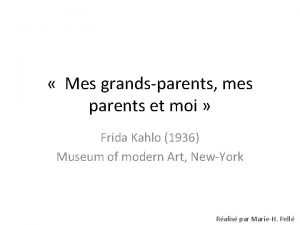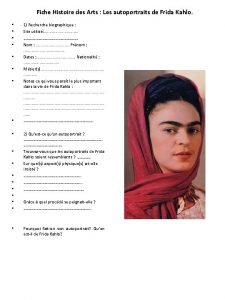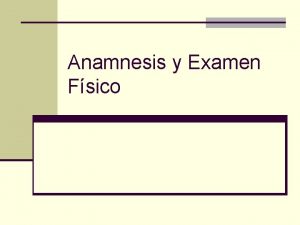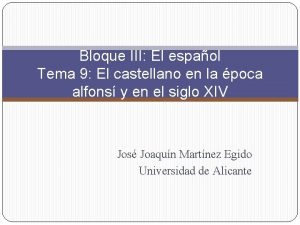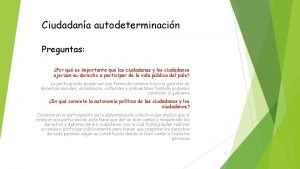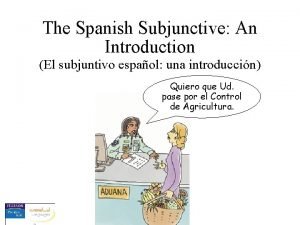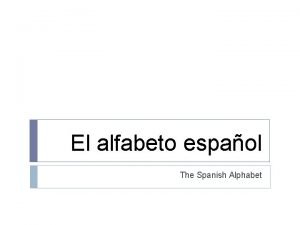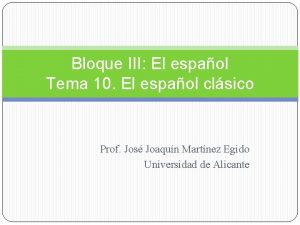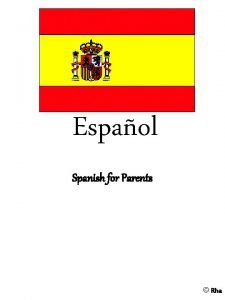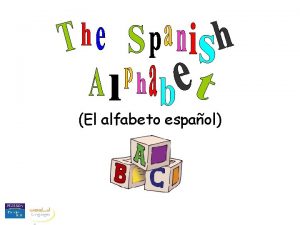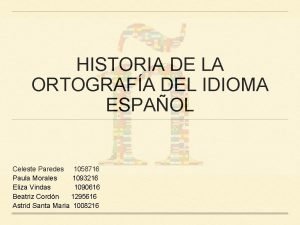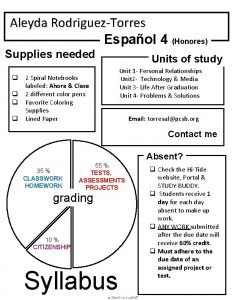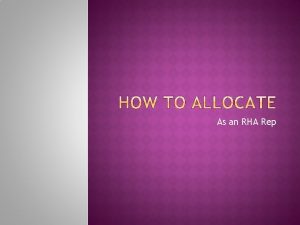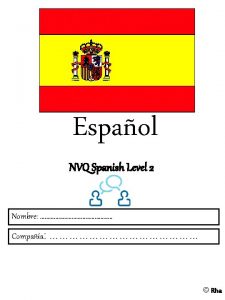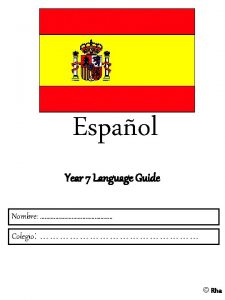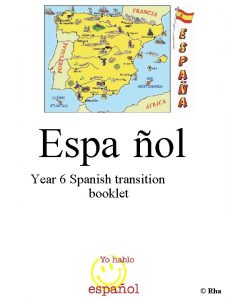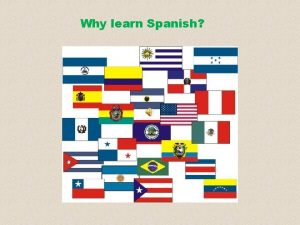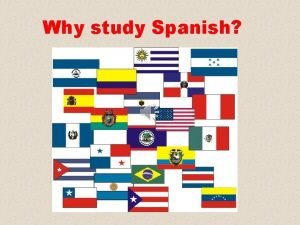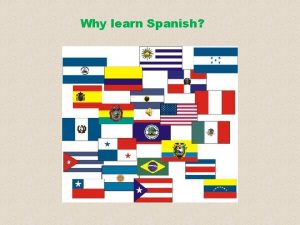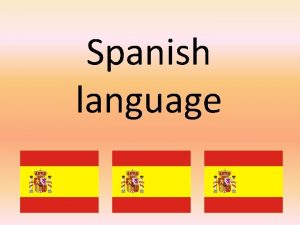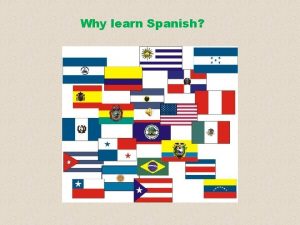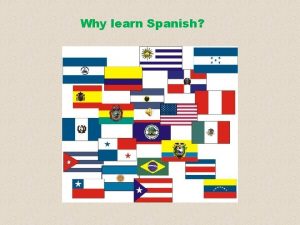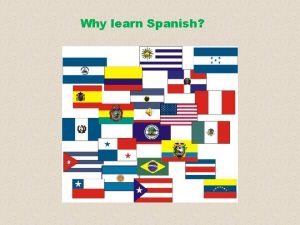Espaol Spanish for Parents Rha 2 3 4
















- Slides: 16

Español Spanish for Parents © Rha

2 3 4 idea 1 araña 5 elefante 6 universo 9 7 cerdo 10 coche 13 España olvidar ciclista 11 cucaracha gimnasia 14 zumo 15 guitarra 8 casa 12 hamburguesa 16 llave

Tips for pronouncing Spanish The good news about Spanish pronunciation is that it obeys clear phonetic rules, although people do speak with different accents, depending on their region and background. Vowels Each of the five vowels has its own clear sharp sound: a as in hat e as in pet i as in feet o as in clock u as in drew c's and z's c + e = th c + i = th z + a, o, u = th c + a = ka c + o = ko c + u = ku cero, once cinco, gracias zapato, corazón, azul casa, catorce cómo, color Cuba, cubano j's and g's J, as in jardines (gardens), is a harder, stronger version of the English 'h'. G, when followed by e and i, sounds exactly the same as j. Otherwise, it is pronounced as the English 'g' in go. ll's The double ll, as in calle, is another characteristic Spanish sound. In most parts of Spain it's like the 'lli' in the English million. h’s The h is silent in Spanish, so you won’t be blowing any candles out when you pronounce words that begin with this letter. Best to imagine it’s not there and pronounce the second letter in the word. hablo, helado, ¡hola!, huevo

KS 3 Spanish Core Language tener – to have Pronouns yo – I tú – you él/ella – he/she Usted – you (polite, sing. ) nosotros – we vosotros – you (fam. pl. ) ellos/ellas – they Ustedes – you (polite, pl. ) ser – to be tengo I have soy I am estoy I am tienes you have eres you are estás you are tiene he/she/y ou have es he/she is/you are está he/she is/you are (pol. sing) tenemos we have somos we are tenéis you have sois you are tienen they/you have son Time words ahora – now antes – before después – after hoy – today ayer – yesterday mañana – tomorrow otra vez - again siempre – always a menudo – often a veces – sometimes nunca – never la semana pasada – last week la semana que viene – next week puedo/puede estar – to be (fam. pl. ) (pol. pl. ) Referring to things una cosa – a thing esto – this eso – that algo (más) – something (else) otro – (an)other mucho – a lot (un) poco – (a) little muy – very todo – all/everything (pol. sing) estamos we are (fam. pl. ) está you are they/you are (pol. pl. ) están they/you are (pol. pl. ) Referring to places aquí – here allí - there Making links (fam. pl. ) Asking questions ¿Por qué? – why? ¿Qué? – what? ¿Cuándo? – when? ¿Dónde? – where? ¿Quién? – who? ¿Cuánto(s)? – how much/many? ¿Cómo? – how? y – and o – or también – also pero – but Opinions porque – because con – with Pienso que – I think that sin - without Creo que – I believe that Me parece que – it seems Sentence building that. . I can/he, she can quiero/quiere I want to/he, she wants to… tengo que/tiene que I have to/he has to… voy a/va a + verb I’m going to/he is going to… (no) me (le) gusta I (don’t) like to/he doesn’t like to me (le) encanta I love to/he loves to… me (le) gustaría I/he/she would like to… Saying what you did fui – I went hice – I did ví – I saw jugué – I played comí – I ate bebí – I drank

How to say ‘a’, ‘some’ and ‘the’: definite and indefinite articles un a (masculine object) una a (feminine object) unos some (more than one masculine object) unas some (more than one feminine object) el the (masc object) la the (fem object) los the (more than one masc object) las the (more than one fem object) NB: Sometimes the article is not needed in Spanish: e. g. No tengo hermanos = I haven’t any brothers or sisters e. g. Mi padre es profesor = My dad is a teacher El abecedario español A a J jota R erré B bé K ka S essé C thé L ellé T té D dé M emé U oo E é N ené V oobé F effé Ñ eñé W oobé doblé G jé O o X ekees H aché P pé Y ee griega I ee Q koo Z theta NB: ch and ll are no longer separate letters in the Spanish alphabet but you still might see them in older dictionaries. In Spanish most words are written as they are said – you just need to know the key sounds!

España norte noreste noroeste centro este suroeste sureste

ca a i len as res st ri ba le tu le lla as va na ón cia las ri as cia ca mur is 1. 4. 2. 5. 3. 6.

Websites http: //www. combertonvc. org CVC school website http: //spanish. typeit. org This is an excellent site – you can type any text with Spanish accents in here and then copy/paste to word. Very easy to use!!!! http: //www. videojug. com/webvideo/how-to-describepersonality-in-spanish ¿Cómo eres? Soy + character adjectives in Spanish. (5 minute video) http: //www. spanishrevision. co. uk/ks 3 This site is excellent for revision – it has listening material too! http: //oye. languageskills. co. uk This site is free at all times and has lots of interactive activities for the basics. Definitely worth visiting – easy to navigate too. http: //www. linguascope. com Students have a school username and password for this site http: //www. asisehace. net This site is free – most of its material is more advanced but the Relaciones personales section is useful to you now. http: //atschool. eduweb. co. uk/rgshiwyc/school/curric /hotpotatoes/ This site is called Languages Online – it has lots of language learning activities for Spanish, French, German & Italian. http: //www. bbc. co. uk/languages/spanish/ http: //www. freerice. com/index. php? &t=18127850318&s= Spanish The BBC website has a lot – it has a course called Spanish Steps for beginners, and a real Spanish drama series called ‘Mi Vida Loca’ which is brand new, as well as some slang and holiday phrases to learn. For each answer you get right on this website 10 grains of rice are donated to help the world’s hungry. http: //www. espanol-extra. co. uk/index 2. html Students are given a login for this website as we hold a subscription to it. Lots of interactive activities. Choose CORE once you’ve logged in. http: //www. bbc. co. uk/learningzone/clipsl Archived 2 -3 min digitized video clips in a database sorted by theme – easy search facility – some v good things in here to use! Search for Anansi y la tortuga http: //www. digitaldialects. com/Spanish. htm Click on Spanish (there are lots of other languages too) and follow the links to different activities.

Learning Styles What is a learning style? A learning style is simply a preference for the method by which you learn and remember what you learned. Where do learning styles come from? Your learning style will be influenced by your genetic make-up, your previous learning experiences, your culture and the society you live in. You may have some scores in each of the 3 learning styles but you will usually have a preference for 1 style. Why is it important to know about them? Your learning style will indicate how you (prefer to) learn, the types of learning activities that work best for you. If you know about your own learning style you can be more independent and more successful in your learning. Is my learning style fixed? You will always have the natural strength in your preferred learning style(s) but you can increase your learning power and use more of your brain by adding other learning style strategies to your preferred style. NB: Exams are mostly given in the visual, written learning style. Visual input and retrieval strategies work best for those types of exams. If you want to do a very short learning styles inventory to see which your preferred learning style is, go to www. howtolearn. com - you will have to register with your email address. I have done this and you receive further emails from the site, which are easy to ignore/delete. It has not led to any increase in SPAM!

Visual Learning Style • learns best by seeing • neat, orderly • speaks quickly, holds head up, shoulders erect • good long range planners • good spellers • memorises by strong visual associations • functions best with overall view before proceeding • has trouble remembering verbal instructions – unless written down Auditory Learning Style • learns best through hearing • likes to listen to talks, music or lectures • good story tellers • talks to self • likes talking more than writing • easily distracted by noise – generally can’t listen to someone talk on phone and listen to another person talking to them at the same time • may have problems with projects involving visualisation • likes jokes better than comics Kinaesthetic Learning Style • learns best by doing and through movement • often good athletes • speaks more slowly • memorises by moving around, walking etc. . • gestures a lot • doesn’t mind clutter/mess in workspace • using action words when speaking • wants to act things out

Some strategies for the 3 learning styles Visual Concept maps with pictures to represent words Spider diagrams also using images Mental movies Auditory Talk out loud Listen to others explaining material Read notes out loud Use rhymes Learn with music Make tapes of the material and listen to them Teach others out loud Kinaesthetic Walk or pace around (regular, steady steps) Learn in groups Create games Make notes on post-its and arrange on a big sheet (A 3) Act out material you are learning

The key is to match the learning strategy and input style to the way in which you are going to be tested on that material: • if you are going to take a test out loud (oral) then study the material aloud and rehearse it aloud • if you are taking a test by acting things out or demonstrating physically that you understand something then study the material in the same way. (you would not rehearse a stage production by writing lots of notes) • if you are taking written tests, make sure you are making visual pictures as you learn the material so you can retrieve these later in the test. Rehearse the test in writing while practising visual images and this will help to fix the learning in your long-term memory.

The importance of Visual Memory Techniques Because most tests are written, and retrieval of verbal information (words) is greatly enhanced when the learner has stored pictures/is using visual memory, all learners will want to improve their ability to ‘visualise’ when they learn. Research has found that one way to do this is by making use of the natural eye-brain connection that exists. Visual learners look upward and to the side when recalling or processing information and project images onto an imaginary screen. To locate your own visual memory, do the following with a partner: Answer one or several of the following questions: Get a picture of your best friend in your mind. Tell me exactly how he or she looks. What colour is his/her hair, eyes etc. ? What does his/her favourite item of clothing look like? What was your mother/friend/teacher/brother/sister wearing yesterday? Get a picture of him/her in your mind and describe what he/she is wearing. Describe your favourite film to me. Tell me exactly how a favourite character or scene looked. What were they wearing? How did they look when a certain event happened? Describe the location. Was there any interesting equipment in the film? A specific car, plane, boat, jet ski? Describe it to me exactly. Colour, type, specific markings etc… What does a picture in your room look like? Describe it to me exactly. Watch your partner’s eyes carefully. When he/she begins to create a picture and describe it to you, he/she will look upwards either to the right or the left, (or very occasionally up and in front) Recreating this eye movement when trying to visualise new knowledge whilst learning and then again when trying to recall it will greatly enhance your ability to remember.

Brain researchers have shown many times that the power of memory is multiplied many times if we connect an association to the picture asking What does this sound like/remind me of? An association is simply something that is connected to and reminds us of something else. Author David Sousa says, “Whenever two events, actions or feelings are learned together they are said to be associated or bonded, so that the recall of one prompts the spontaneous recall of the other. The word Romeo elicits Juliet, Batman gets Robin. ” Word-Picture association 1. Choose a word, look at it and say it out loud. 2. What does the sound of the word remind you of? (at this stage don’t think of the real meaning of the word, only what the sound of the word makes you think of) 3 Now think of the actual meaning of your new word. Create a picture (looking up and to the side) in your mind of your association and the real meaning of the word – make the mental image as humorous and detailed as you can and hold the picture in your mind. 4 Now draw the picture – use as much colour as you can as this also enhances memory! 5 Now write the word under the picture you have drawn. 6 In another colour write the English meaning of the word in the top corner (right or left depending on where your visual memory is) of the card. 7 Hold your card up above eye level in your own visual memory position and say the word and the English meaning several times. 8 Now you are going to be tested on this vocabulary – sit as if you are successful! 9 As you are recalling each word, use your visual memory – look upward and to the right/left.

Step – by – step successful spelling 1. Write the word onto a piece of coloured card, using different coloured pens to emphasise unique letters which do not sound as they are spelled. 2. Hold the card up in your visual memory location – up to the left or up to the right. 3. Trace the letters with a finger (still holding card in visual memory position) and saying the word aloud. 4. Take a mental snapshot of the word – imagine a camera in your brain taking a picture of the word and storing it on your visual memory screen. 5. Write the word down on your paper. Look up and remember (visualise) how it looked on the visual memory screen. 6. Compare what you wrote down with the word card. Expect success! Ideas and strategies for the leaflet were drawn from many sources and teacher experiences but the website www. howtolearn. com was a key source.

Learning styles & memory How to improve your ability to learn and retain new words A booklet for parents and students
 Mes grands parents et moi
Mes grands parents et moi Parents parents
Parents parents Frida kahlo histoire des arts
Frida kahlo histoire des arts Corazón rr2tss
Corazón rr2tss Apa itu rha
Apa itu rha El espaol
El espaol Preguntas de ciudadania en espaol
Preguntas de ciudadania en espaol Escapaa
Escapaa Spanish alphabet letters
Spanish alphabet letters Penas graves
Penas graves Trabajos en espaol birmingham
Trabajos en espaol birmingham El espaol
El espaol Puntos cardinales mapa españa
Puntos cardinales mapa españa Abecedario espaol
Abecedario espaol Idioma espaol
Idioma espaol Miguel hidalgo preguntas
Miguel hidalgo preguntas Citizenship test en espaol
Citizenship test en espaol
